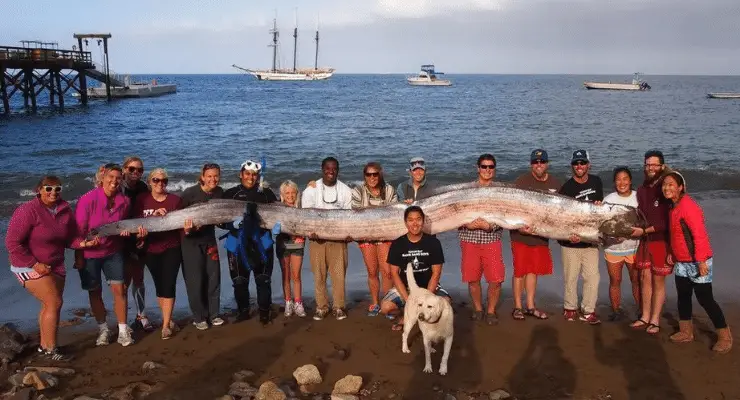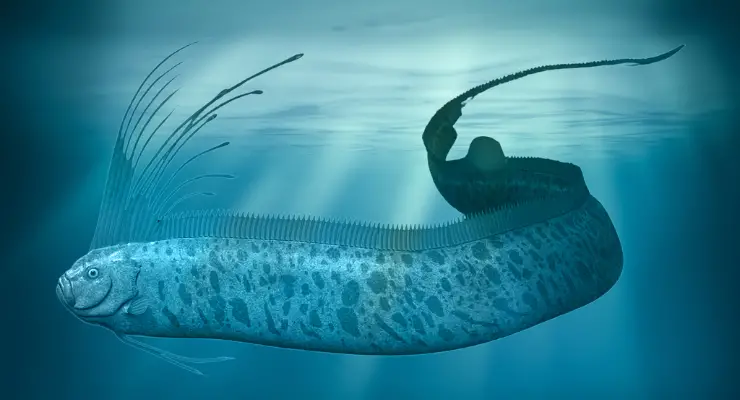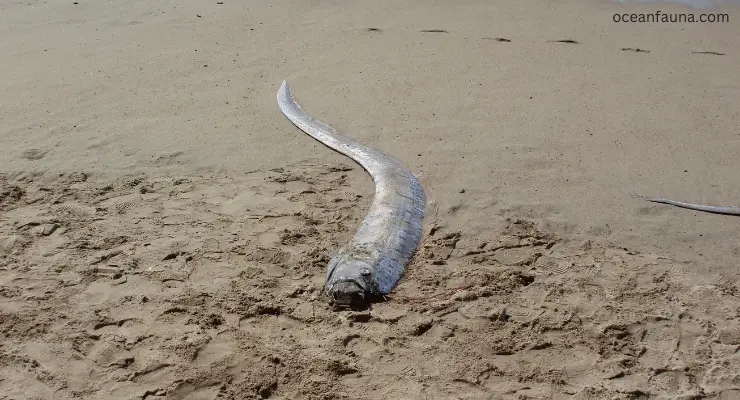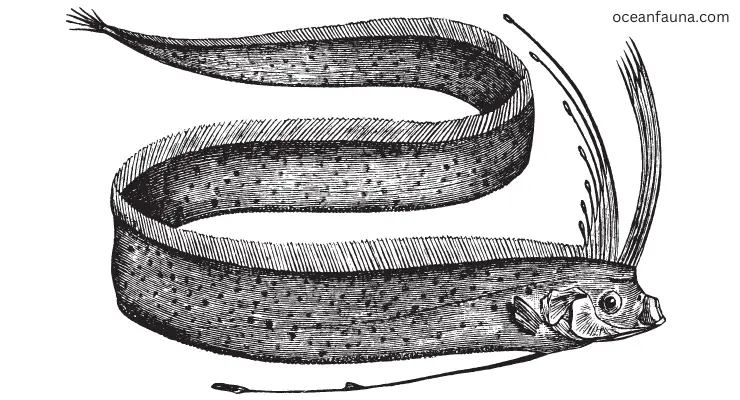Oarfish are mysterious. With a gigantic body structure and living in a depth of around 200 to 1000 metres, they’re often known as sea monsters to many. However, in reality, Oarfish are often considered friendly and harmless. It sounds really confusing, right? There are so many incredible oarfish facts to know.
The rare appearance of Oarfish and the lack of information about their lifestyle make them more mysterious. But are Oarfish really dangerous? Are they friendly? What makes them sea monsters?
So, if you’re one of those who are eager to know about Oarfish and discover the undiscovered, you’ve arrived at the right place. This guide will cover 20 amazing Oarfish facts. And we believe it’ll expand your knowledge, and you will learn about some unknown facts regarding Oarfish.
So, keep reading to the end…
20 Incredible Oarfish Facts
Oarfish seldom come to the shore. Most of the Oarfish that were seen were mostly dead. As the dead ones are mostly carried to the shore by heavy currents of seas or oceans, people become really excited seeing them and want to have more insights about them.
So, if you’re also one of them, we bring you this article where we’ll be sharing some of the amazing oarfish facts with you.
1. Taxonomy
There are around 55,000 species in vertebrates, and Oarfish is one of them.
Osteichthyes belongs to Actinopterygii. And Actinopterygii contains all the largest groups of fishes and the largest class of vertebrates. And Oarfish falls under one of the 28000 species of Osteichthyes.
Also, Oarfish falls in the order Lampriformes, under the family Regalecidae. And their scientific name is Regalecidae.
To make things easy and better understating,s here’s a chart that describes the taxonomy of Oarfish-
| Order | Lampriformes |
| Family | Regalecidae |
| Genus | Regalecus |
| Species | glesne |
2. Oarfish Have Gigantic Size
Oarfish have a huge body structure and shape. Typically, Oarfish can reach a length of about 36 feet or 17 metres and weigh around 200 kg.
There have been reports that Giant Oarfish can surpass this length, grow up to 56 feet, and weigh around 300 kg.
The body shape of an Oarfish is a little bit different and unique compared to other marine fishes. They have a long and elongated body shape that is tapered toward the tail. On top of that, they have a big and concave head profile.
3. Oarfish Are World’s Longest Bony Fish
As you already know, Oarfish are massive in length. Due to their elongated shape and size, Oarfish are considered the longest bony fish.

Very often, Oarfish are called “king of herrings” because they have a resemblance to tiny marine fishes. But as they have long pectoral fins, that’s why they are known mainly as Oarfish as the long pectoral fins resemble oars.
4. Oarfish Have No Scales
Like other fishes or marine creatures, Oarfish have no scales on their body. The giant fish have silvery guanine. Also, they have skin in place of scales.
The outer surface or body of Oarfish is quite smooth and gives a shiny look compared to other marine creatures or fishes.
Oarfish have tubercles and a coating of silver in their outer body structure. The silver coating on their body is called guanine. The guanine helps them to absorb high pressure underneath the water. But when Oarfish come to the shore or surface, their skin becomes soft and gets damaged easily.
Alongside having no scales, the swim bladder is also absent in the body of Oarfish.
5. Oarfish Have Long Fins
Oarfish have long dorsal fins that start from the eyes and end at the tip of the tail. That means the dorsal fin is present along their entire body.
Alongside dorsal fins, Oarfish have pectoral fins as well. The pectoral fins are comparatively thick and stiff.

On the other hand, Oarfish have long pelvic fins that have a single ray in each of them. The long pectoral fins resemble oars. And that’s why this long bony fish is known as an “Oarfish.”
Besides having long fins, Oarfish swim in an upright position. That means, unlike other fishes, Oarfish swim vertically.
The reason why Oarfish swim vertically is that they can easily detect their prey and capture them. The head remains in an upright position, and they use the long fins for swimming through the deep waters.
6. Oarfish Respire Through Gills
Oarfish are indeed unique and mysterious. They have many unique physical properties that are completely different from other marine creatures.
However, there are quite a few similarities as well. And among the similarities, the respiration process of Oarfish is similar to other fishes.
Oarfish respire through gills. You already know that they have got a gill raker for capturing foods. Modified bones support the special gill raker. And the gills are also supported by these modified bones and help in respiration.
7. Oarfish Have No Teeth
Yes, it might sound weird, but the longest bony fish in the world has no visible and real teeth. So the question is, how do they eat?
Oarfish have a special gland called the gill raker. They have numerous gill rakers present in their mouths.
The gill rakers are made of flimsier structures, and with the help of the gill rakers, oarfish capture and intake food like plankton, krill, shrimp, and tiny fishes.
8. Oarfish Live in Temperate and Saltwater
Oarfish are mostly found all over the world. But specifically speaking, they are mostly seen around the Atlantic Ocean, Mediterranean, and Eastern Pacific Ocean.
Alongside the geographical location, Oarfish prefer to live in tropical and temperate waters. They need saltwater bodies for a living. That’s why they are mostly found in seas and oceans other than rivers or streams.
Oarfish cannot live in too hot or too cold waters. They need salt and temperate waters. And that’s why they are known to be living around the Atlantic Ocean.
Besides, it’s believed that a large number of Oarfish live around the water bodies of Japan. And that’s why there have been various myths regarding Oarfish around Japanese People.
9. Oarfish Have More Lifespan Than Other Fishes
Generally, marine creatures of fish have an average lifespan of around 2 to 4 years. But in the case of Oarfish, they have a lifespan of around 10 years.

Oarfish are rare. And the fact that they’re rare, some accurate information regarding their life span is still unknown to many.
But we’ve discovered the undiscovered, and in our research, we’ve found out that, generally, Oarfish have a lifespan of around 10 years. This is the same for giant Oarfish too.
But the time period between baby oarfish to adult is still unknown. If you know this, comment it down below so that others can get enlightened as well!
10. Oarfish Live in Deep Waters
Oarfish live in deep waters. But the question is, how deep? Well, the natural habitat of Oarfish is around 200m in the ocean. However, it’s also found that some oarfish live around 1000 m in depth also.
The body shape and structure of Oarfish have good adaptability. They can live in high pressure around deep waters. But on surfaces or shores, Oarfish cannot survive for too long.
That’s why Oarfish are seldom seen on shores or beaches. They need deep water and the right water pressure.
11. Oarfish Live on Planktons
It might be hard to believe and digest, but Oarfish indeed live on plankton. Alongside plankton, the main food of Oarfish is tiny marine creatures, shrimp, krill, and squid.
Being so massive and gigantic in shape, it’s quite natural to think that Oarfish eat big fishes. But as they are carnivorous, they live by eating plankton and tiny creatures.
The food habits of giant Oarfish is the same as well. Except for the massive size, every other thing of giant Oarfish is the same as regular Oarfish.
12. Oarfish Lay Eggs
People often mix up Oarfish with whales and end up thinking that Oarfish are mammals, and they give birth to their offspring. But it’s totally wrong.
Oarfish lay eggs just like regular fish, and the baby oarfish are hatched and released into the water.
It’s believed that it takes around 3 weeks for the eggs to be hatched and develop into larvae. Besides, female fishes carry around 140,000 eggs in their stomachs at the time of pregnancy.
Although the number of eggs is too many, the survival rate is quite low. And the main reason is not all eggs can hatch properly and turn into larvae. Besides, once the baby oarfish are hatched, they go into the sea. And they’re eaten by other marine creatures.
Oarfish generally lay their eggs around plankton. And the planktons carry the eggs to the shore.
A surprising fact about Oarfish is the parents provide no protection or care to their babies once they’re hatched. The babies have to survive in the dangerous marine world among many predators all by themselves.
13. Oarfish Are Friendly and Harmless
There’s a common myth regarding Oarfish that they’re dangerous. But in reality, Oarfish are one of the friendliest marine creatures and are totally harmless.
There hasn’t been a single case found where Oarfish caused any harm to people. Even mariners never complained about Oarfish harming their boats and making any mischief.
The main reason Oarfish are considered dangerous is their gigantic shape. As they are too long and have a massive weight, people often think that they are dangerous. But researchers found that Oarfish are peace-loving and do no harm to other marine creatures.
On top of this, as Oarfish rarely come near humans or shore, this makes them fully harmless, and there’s no need to think of them as dangerous!
14. Oarfish Are Not Sea Monsters
For centuries there have been tales of sea monsters, and due to the massive shape of Oarfish, people considered them sea monsters.
The first term of sea monsters came from fishermen when they saw this gigantic fish in the ocean for the first time. Due to their rare appearance and massive size, they were thought to be sea monsters and dangerous.
However, Oarfish are friendly and harmless. So, they are neither dangerous nor sea monsters!
15. Oarfish Are Not Sea Serpents
Sea serpents are mainly mythological. In the past, people considered undiscovered big and giant fish snake-like structures as sea serpents. There are thousands of tales of these sea serpents.
The first time Oarfish was discovered was in 1772. And before this time, the stories of sea serpents prevailed. As Oarfish are long, elongated, giant-shaped, and move like a snake, they were thought to be sea serpents.
This is clearly a myth, and in no way are oarfish sea serpents!
16. Oarfish Cannot Predict Earthquake
Another myth regarding Oarfish is that Oarfish can detect earthquakes.
For years people used to believe that Oarfish could predict natural calamities like earthquakes and tsunamis. And there were valid reasons for this too!
One Oarfish was caught alive in Japan in 2017. And after a couple of days, an earthquake happened in that part of the country. Even before that, people believed in this and thought that Oarfish come to shore only when there are possibilities of Earthquakes and Tsunamis.
But researchers found no real evidence of this fact. And they clearly stated that Oarfish have no capability of predicting natural calamities.
So “oarfish can predict earthquakes”- it’s a complete myth!
17. Oarfish Are Edible
You might not believe it, but Oarfish are actually edible. But there’s a catch!
Oarfish are deep water habitats. And due to this, they have little to no commercial value. On top of that, the meat quality of Oarfish is very poor. It feels rubbery and gelatinous. Due to the flabby and gooey taste of the meat, people haven’t found them tasty!
18. Predator and Prey of Oarfish
As you already know, Oarfish are giant in shape and size. So it’s quite normal to think that they have no predators, right? But there’s a catch!
Oarfish have predators. The predators of Oarfish are mainly sharks and killer whales. Besides them, some big fishes are also predators of baby oarfish.
When baby oarfish are released into the water after birth, big fishes catch and eat them as food.
Now coming to the prey, oarfish prey on zooplankton, tiny marine creatures like shrimp, krill, squids, etc. They are carnivorous and use the gill raker in their mouth to suck their food and eat them.
As zooplanktons are the primary food of Oarfish, they’re often found living around plankton and coral reefs.
19. Oarfish are Rare and Endangered
Undoubtedly, Oarfish are rare! There have been a handful of cases where alive Oarfish were found on the shores. In most cases, dead or injured Oarfish come to the shore with the currents.
The number of Oarfish is declining gradually. A female oarfish carries around 140,000 eggs in it. But if you see and look at the common statistics, there aren’t many left, seen, or known Oarfish.
On top of that, there have also been cases where fishermen catch them while fishing.
So the number of Oarfish is declining gradually. But the exact number of alive Oarfish is yet to be known!
20. Oarfish Cannot Be Kept in Aquariums
For years, people have been keeping fish in aquariums. So the question arises, can I keep Oarfish in aquariums too?
No, you cannot keep Oarfish in aquariums as they cannot survive there.
Oarfish are deep-water fish. They live hundreds of metres below sea level. Their body is structured in such a way as to absorb the water pressure underneath. Besides, Oarfish need temperate waters. On top of that, some studies have found that Oarfish need saltwater for survival.
Maintaining everything in an aquarium is nearly impossible. Moreover, Oarfish can get up to 30 ft in length. On top of that, when Oarfish come near the shore, the outer part of their body becomes soft, and they are easily damaged.
One Oarfish was kept in an aquarium in Japan, and it died within a few hours.
So considering all these, Oarfish cannot be kept in aquariums like normal fishes!
Conclusion
So that’s all on knowing about Oarfish! Reading this far and knowing about all these amazing, mind-blowing facts, I bet you’re surprised, right?
The rare appearance, unique and gigantic body structure, and living habitat certainly make Oarfish different from other fishes. And for years, they remained undiscovered, and people knew only little about them!
So, we dived deep into the matter, left no stone unturned, and brought out 20 amazing Oarfish facts to provide detailed knowledge and information about Oarfish.
As you’ve read this far, we assure you that now you know everything about Oarfish. So now it’s your turn to enlighten others!


3 thoughts on “Oarfish: 20 Real and Incredible Oarfish Facts”